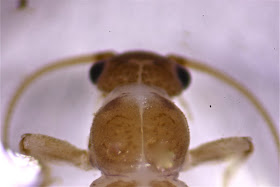Sunday, April 24, 2011
The Nemourid genera: Nemoura and Amphinemura
We have at least two genera of Nemourid stoneflies in our area streams: Nemoura and Amphinemura.
I've reported on both in previous entries (see the entries on 1/30, 2/24, 3/2, 3/10, 3/28, and 4/19). Still, I thought it might be worthwhile to sum up what we know.
The photo above is genus Amphinemura, taken this morning (4/24) at Mechunk Creek: the photo below is genus Nemoura, taken on 3/1 at Buck Mt. Creek.
First, let's note similar and different physical features. One: the nymphs of both genera are basically brown, though I would argue that Nemoura nymphs are a darker brown than the Amphinemura. Two: in both genera the corners of the upper edge of the primary wing pads are squared off in appearance (in this they differ from large winter stoneflies). Three: in both cases, there is a light colored stripe that runs from the head to the end of the wing pads, and on the head, this stripe takes the shape of a "T". Four: the head in both nymphs has a triangular shape. And five: with the tarsal segments on the legs of both genera, segment 1 is longer than segment 2 (remember that this helps us distinguish Nemourids from large winter stoneflies.) This can be seen in the photo below.
How do they differ, anatomically speaking? The obvious difference is that Amphinemura nymphs have cervical gills (frilly gills sticking out from the neck); Nemoura nymphs do not. The Amphinemura gills are pointed out in the picture below.
But there is a second distinction to make -- one that can also be seen with the naked eye. The pronotums are not shaped the same. The pronotum on Amphinemura is large and squared off; on Nemoura it's not as big and it's more rounded. Note the photo of the Nemoura pronotum below.
There are two other matters that are important for us to discuss. The first is that the two genera are not -- I think -- in our streams at the same time (at least that's what I would conclude from the work that I've done). My first sighting of a Nemoura Nemourid was on 2/20 at Elk Run, a small tributary to Buck Mt. Creek; my last sighting was on 3/4 at a small tributary of the Moormans River. All nymphs that I saw seemed to be fully mature. I did not see an Amphinemura Nemourid until 3/28 at Powells Creek, and it was very, very small. The first time I saw one with its well-defined shape was on 4/19 at Long Island Creek. So, my impression is that Nemoura Nemourids are around in the winter; Amphinemura Nemourids are around in the spring.
Finally, I'm not sure that these nymphs inhabit the same kinds of streams: they may have different habitats that they prefer, and Nemoura nymphs may be less tolerant of stream impairment than Amphinemura (though I have found both genera in Buck Mt. Creek). In the winter, I found Nemouras in Elk Run, the Rapidan River, the Moormans River and one of its tribs, and Buck Mt. Creek. If we look at the data from StreamWatch, Amphinemura Nemourids are really prolific in Fluvanna County (i.e. further away from the mountains). (Note: StreamWatch does not ID to the level of genus, but I know from working with them that in their files, "Nemourid" means "Amphinemura".) Major Amphinemura streams include: Cunningham Creek, the Fluvanna County reference site, Long Island Creek, Mechunk Creek, and Raccoon Creek. However, let me quickly note that I have found Amphinemuras in Powells Creek (near Crozet) and the Doyles River -- both of which are close to the Blue Ridge.
I hope these observations will encourage more study of this very interesting stonefly. Clearly, my thoughts on where and when we see these genera are not based on a thorough investigation.
__________
3/31/12: Note. The Nemourids I found in the winter were actually genus Prostoia -- not Nemoura. See the entry for 1/17/12.





No comments:
Post a Comment